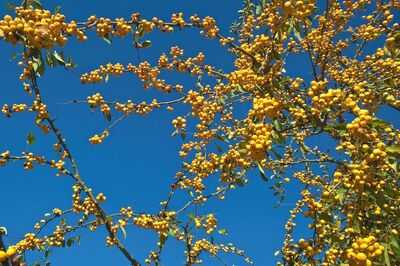According to folklore there are key indicators within our environment which can help to predict just how cold a winter will be.
Old weather lore and science suggest that taking a look at natural signs of nature can help indicate the weather in the months that lie ahead. From the way that squirrels build themselves a habitat to the growth of trees andplants, there are clear signs we may have been ignoring all along.
A particular legend claims that if you spot multitudes of berries, nuts, and flowers growing in trees, it is a sign of a lovely and warm November. However, it also suggests that wintermay be more challenging in terms of weather conditions.
- Get rid of bad fridge smells by spraying simple solution using 1 common ingredient
- Big Brother reveals four housemates facing eviction as fans fume over 'unfair' immunity
Other signs of a difficult winter when it comes to freezing temperatures include observing the birds and the bees. Take a look at the way in which the birds migrate early and the bees tend to build nests higher up in the treetops.

This is indicated in an old folklore saying: "See how high the hornets' nest; 'twill tell how high the snow will rest." But they aren't the only creatures that provide tell-tale signs of the weather that lies ahead, Almanacreports.
Worms are also a signifier of a cold and dreary winter. When you spot fuzzy-looking worms, you should look out for bands of brown and rust on them; this tells you that the winter ahead of you will be cold.
Another Gardener's Rhyme which links back to a cold and snowy winter which has been in folklore tales for years points towards thicker onion skins being a clear signal. It says: "Onion’s skin very thin, mild winter coming in; onion’s skin thick and tough, coming winter cold and rough."

Other signs often spoken about as cues for a harsh winter are thick skins on apples, thicker than usual corn husks and flowers blooming well into autumn. Not forgetting that when the leaves drop early, it's believed to be a sign of a mild autumn and winter, but when they drop late, it suggests a cold and drowsy end to the year.
There is science to back some of these predictions up, based on natural climate phenomena which relate to the temperatures of the oceans. The first one is referred to as La Niña, where weather conditions tend to be dry in the summer and cold in the winter.
It implies that if birds leave early or the leaves fall quickly and onions and apples are tough, there could be a signifier that it's a La Niña drought. In turn, a miserable La Niña winter is expected to follow.
As well as this, there is the El Niño climate phenomenon, in which conditions typically result in wetter than usual weather conditions from Southern California in the U.S. to the Gulf Coast. Along with it comes drier-than-average conditions in the Pacific Northwest of the U.S.
You may also like

At 48, how Shakira maintains her iconic physique: Singer's trainer shares exact meals and special cardio routine

The Chase viewers switch off minutes into ITV show as they blast 'What's going on!'

Indian immigrants most economically beneficial group to US: Study

Rajnath Singh interacts with newly formed Bhairav Battalion at Longewala Battlefield

Delhi govt announces public holiday on October 27 for Chhath festival






